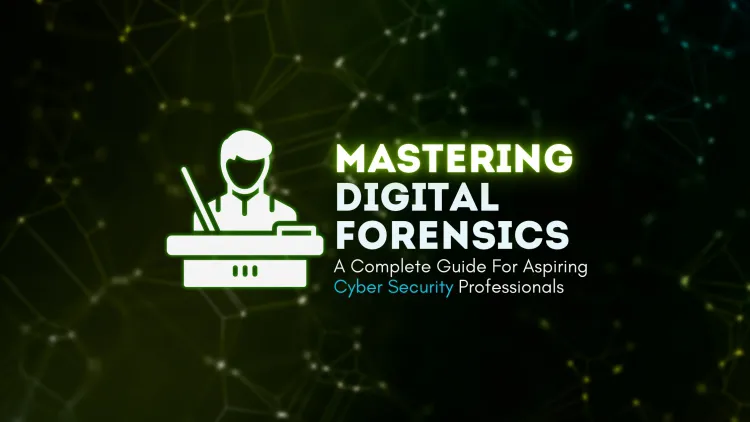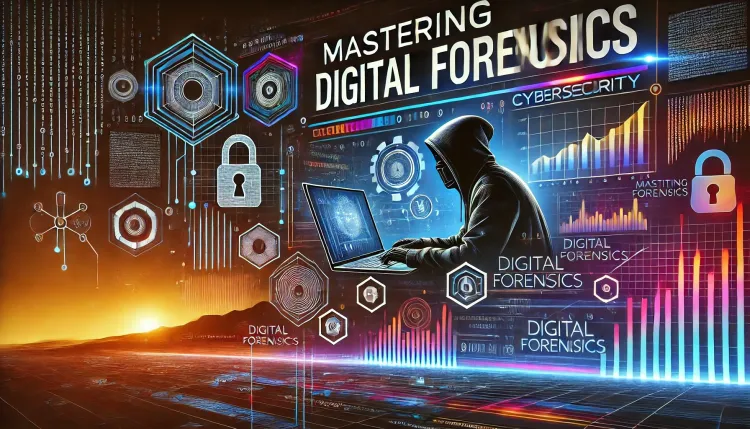Mastering Digital Forensics | A Complete Guide for Aspiring Cybersecurity Professionals
Digital forensics is vital for investigating cybercrimes and ensuring the integrity of digital evidence. With courses and certifications from institutes like Webasha Technologies in Pune, you can gain the skills needed to pursue a career in this growing field. Mastering tools such as EnCase, FTK, and Wireshark, along with staying updated on emerging trends, will ensure you are well-equipped to tackle the challenges in digital forensics and cybersecurity.

Digital forensics is an essential and rapidly evolving field in cybersecurity, law enforcement, and criminal investigations. It is the process of collecting, analyzing, and preserving digital evidence to uncover criminal activities and provide accurate data for legal proceedings. This blog will explore what digital forensics entails, why it is crucial, the key tools involved, and how you can build a career in this area by leveraging the right study materials, institutes, and specialized courses.

What is Digital Forensics?
Digital forensics refers to the application of investigative techniques to digital devices such as computers, mobile phones, networks, and even cloud environments. The goal is to uncover digital evidence related to illegal activities like hacking, fraud, intellectual property theft, and cybercrimes. A digital forensics investigator is tasked with identifying, preserving, extracting, and analyzing digital evidence in a way that makes it legally admissible in a court of law.
The process of digital forensics is systematic, ensuring that data is collected without alteration, and every step can be traced for legal and compliance purposes. It involves handling data from a range of devices, including:
- Hard Drives and Computers
- Mobile Devices (phones, tablets)
- Cloud Platforms
- IoT Devices
- Network Devices (routers, switches)
The Essential Digital Forensics Process
The digital forensics process follows a sequence of stages to ensure the integrity and authenticity of evidence:
1. Identification
The first step in digital forensics is identifying the sources of potential digital evidence. This could include devices, online storage, or network traffic.
2. Preservation
Once identified, the evidence must be preserved in its original form. This involves creating an exact copy of the data to ensure that the evidence remains intact and uncontaminated.
3. Analysis
In this phase, investigators analyze the data to uncover hidden or deleted files, trace digital footprints, and recover data that may lead to the identification of criminals or unauthorized activities.
4. Documentation
Proper documentation is essential in digital forensics. Investigators must create detailed reports of their findings, including the tools used, methodologies employed, and the evidence discovered.
5. Presentation
The final step is presenting the evidence in a clear, organized, and legally acceptable format to be used in court or other legal proceedings.
Key Tools Used in Digital Forensics
To effectively carry out investigations, digital forensic experts rely on a variety of sophisticated tools and software. Here are some of the most widely used tools:
| Tool | Purpose |
|---|---|
| EnCase | A powerful tool for disk imaging, data recovery, and forensic analysis. Often used for hard drive analysis. |
| FTK (Forensic Toolkit) | A comprehensive forensic tool that helps recover deleted files, examine emails, and analyze documents and other digital evidence. |
| Wireshark | A network protocol analyzer that helps forensic investigators capture and examine network traffic. It is widely used in network forensics. |
| Autopsy | An open-source forensic tool designed for analyzing disk images and conducting detailed digital forensic investigations. |
| Cellebrite | Specializes in mobile forensics. It helps recover data from mobile devices, including deleted content and media files. |
Why Digital Forensics is Crucial
1. Cybercrime Investigation
With the rise of cybercrime, digital forensics has become a critical part of investigations. It helps authorities trace online criminal activity, including hacking, identity theft, financial fraud, and cyberbullying.
2. Legal Proceedings
Digital forensics provides the necessary evidence that is used in legal proceedings. Whether it's for fraud investigations, intellectual property theft, or other criminal activities, digital forensics plays a vital role in securing convictions and ensuring justice.
3. Corporate Security
Companies also use digital forensics to investigate internal data breaches, unauthorized access, or the theft of intellectual property. It helps in both preventing security breaches and gathering evidence for potential legal action.
How to Start a Career in Digital Forensics
Digital forensics requires a combination of technical expertise and knowledge of legal principles. Below are key steps for building a career in this field:
1. Gain Basic Knowledge of Cybersecurity
Before diving into digital forensics, it is important to have a solid understanding of cybersecurity principles. Learn the basics of networking, security protocols, and common cyber threats.
2. Get Certified
Certifications are highly valued in the field of digital forensics and can help boost your career prospects. Some of the most recognized certifications include:
- Certified Computer Forensics Examiner (CCFE)
- Certified Hacking Forensics Investigator (CHFI) by EC-Council
- GIAC Certified Forensic Analyst (GCFA)
3. Enroll in Specialized Digital Forensics Programs
To gain in-depth knowledge and hands-on experience in digital forensics, it’s important to enroll in specialized programs. Here are some notable institutes and courses that offer comprehensive training:
Study Materials for Digital Forensics
-
Books:
- “Digital Evidence and Computer Crime” by Eoghan Casey
- “Practical Malware Analysis” by Michael Sikorski
- “Guide to Computer Forensics and Investigations” by Bill Nelson
-
Online Resources:
- Cybrary: Free courses on digital forensics.
- SANS Reading Room: Whitepapers and articles on forensics.
- Kali Linux Forums: A great community for tools and techniques.
-
Hands-On Labs:
- Cyber Ranges and Forensic Challenges on platforms like Hack The Box and Cyberbit.
Top Institutes Offering Digital Forensics Courses
-
Webasha Technologies – Pune, India
- Courses Offered:
- Computer Hacking Forensic Investigator (CHFI): An advanced certification program designed for those looking to specialize in cybercrime investigations. It covers topics like evidence recovery, reporting techniques, and legal aspects of forensic investigations.
- Digital Forensics Fundamentals: An introductory course for beginners.
- Advanced Cybercrime Investigation: For professionals who wish to specialize in investigating complex cybercrimes.
- Courses Offered:
-
EC-Council
- Courses Offered:
- CHFI (Computer Hacking Forensic Investigator)
- Certified Cyber Forensics Professional (CCFP)
- Courses Offered:
-
SANS Institute
- Offers courses such as FOR500: Windows Forensic Analysis and FOR508: Advanced Incident Response.
-
Coursera and Udemy
- Platforms offering digital forensics courses like Digital Forensics by Open University on Coursera and Incident Response and Digital Forensics on Udemy.
-
MIT OpenCourseWare
- Free resources and lectures on digital forensics and cybersecurity.
Emerging Trends in Digital Forensics
Digital forensics continues to evolve with advancements in technology. Here are some emerging trends to watch out for:
1. AI and Machine Learning in Forensics
Artificial Intelligence (AI) is increasingly being used to automate the analysis of large volumes of data, identifying patterns, and detecting anomalies.
2. Blockchain Forensics
With the rise of cryptocurrencies, blockchain forensics is becoming essential for tracing illicit transactions and identifying the parties behind cybercrimes.
3. Cloud Forensics
With more businesses moving to cloud platforms, cloud forensics is growing in importance. It involves analyzing data stored on the cloud for security breaches and compliance issues.
Conclusion
Digital forensics is a fascinating and rewarding field with applications across law enforcement, cybersecurity, and corporate security. If you're looking to pursue a career in this domain, gaining hands-on experience, certifications, and specialized education is essential. Institutes like Webasha Technologies offer a range of courses that can help you start or advance your career in digital forensics. As cybercrime continues to evolve, the need for skilled forensic investigators will only increase, making this an exciting and valuable field to explore.
FAQ's:
1. What is digital forensics?
Digital forensics is the process of investigating digital devices (like computers, mobile phones, and networks) to uncover, preserve, and analyze evidence for legal purposes. It plays a vital role in cybercrime investigations, data breach responses, and legal proceedings.
2. Why is digital forensics important?
Digital forensics is important because it helps identify, collect, and preserve digital evidence that can be used in legal matters such as cybercrimes, fraud investigations, and internal company breaches. It ensures that the evidence is admissible in court.
3. What are the types of digital forensics?
The main types of digital forensics are:
- Computer Forensics: Investigates data stored on computers and other storage devices.
- Mobile Device Forensics: Focuses on extracting data from smartphones and tablets.
- Network Forensics: Analyzes network traffic to identify breaches or security incidents.
- Cloud Forensics: Involves the analysis of data stored on cloud platforms.
- IoT Forensics: Analyzes data from Internet of Things devices.
4. What tools are used in digital forensics?
Popular tools used in digital forensics include:
- EnCase: For disk imaging and data recovery.
- FTK (Forensic Toolkit): A forensic tool for file analysis.
- Wireshark: For network traffic analysis.
- Cellebrite: Specialized for mobile device forensics.
- Autopsy: An open-source tool for digital forensics analysis.
5. What skills are required to become a digital forensics investigator?
To become a digital forensics investigator, you need:
- Strong understanding of computer systems, networks, and storage devices.
- Familiarity with forensic tools like EnCase, FTK, and Wireshark.
- Knowledge of legal protocols regarding digital evidence.
- Analytical thinking and attention to detail.
- Certifications like CHFI, CCFE, or GCFA to validate your expertise.
6. What is the difference between digital forensics and cybersecurity?
Digital forensics focuses on investigating and analyzing digital evidence related to incidents, such as cybercrimes or fraud, whereas cybersecurity involves protecting digital assets from attacks and ensuring data confidentiality, integrity, and availability.
7. What certifications are available in digital forensics?
Some of the popular certifications in digital forensics include:
- Computer Hacking Forensic Investigator (CHFI) by EC-Council.
- Certified Forensic Computer Examiner (CFCE) by IACIS.
- GIAC Certified Forensic Analyst (GCFA).
- Certified Cyber Forensics Professional (CCFP) by EC-Council.
8. What is the role of digital forensics in cybercrime investigations?
In cybercrime investigations, digital forensics helps law enforcement uncover hidden data, recover deleted files, trace the identity of perpetrators, and gather evidence to present in court.
9. How do I start learning digital forensics?
To start learning digital forensics, you should:
- Gain foundational knowledge of cybersecurity and networks.
- Enroll in digital forensics courses (e.g., CHFI or online platforms like Coursera, Udemy).
- Get hands-on experience with forensic tools like EnCase and FTK.
- Pursue certifications to enhance your skills and credibility.
10. What is the future of digital forensics?
The future of digital forensics is shaped by advancements in technologies like AI, blockchain, and cloud computing. As cybercrimes become more sophisticated, digital forensics will continue to evolve with emerging tools and techniques for analyzing digital evidence in real-time and across decentralized systems like blockchain and cloud environments.











![Top 10 Ethical Hackers in the World [2025]](https://www.webasha.com/blog/uploads/images/202408/image_100x75_66c2f983c207b.webp)



![[2025] Top 100+ VAPT Interview Questions and Answers](https://www.webasha.com/blog/uploads/images/image_100x75_6512b1e4b64f7.jpg)







